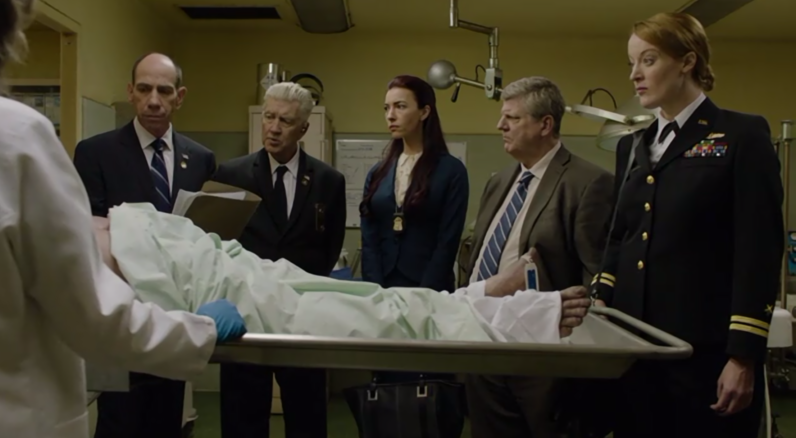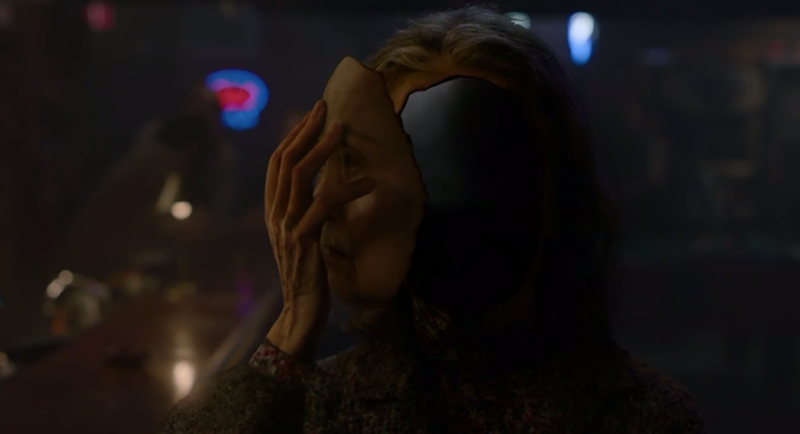Twin Peaks: The Return – Allegory as Alibi?
This summer, in an abbreviated but still smoldering Slow Burn, Len Gutkin, Benjamin Parker, and Michaela Bronstein discuss David Lynch's Twin Peaks: The Return.
You don't need me to tell you that Twin Peaks: The Return, is slow. Almost every review or thinkpiece mentions it; Len placed its "glacial pacing" in conversation with the revival's general coldness of affect. At first it struck me as glacial, too, in its implacable indifference to viewer's desires: for plots to advance, for the "real" Agent Cooper to return, for the distracted Midwestern woman in the first episode to remember her own address so that we can find out what's in that bad-smelling apartment.
A modest thesis: most conversations about the aesthetic status of prestige TV today are really conversations about time: about whether one show will repay the time we spend on it, about whether another is just a way to kill time or a work of art that happens to be inconveniently time-consuming to appreciate. One of the first conversations I had about the new Twin Peaks was about whether it would be better viewed week-by-week or binged in a weekend. The subtext of so many responses to the show vacillates from the evaluative (is it worth the time it demands?) to the analytic (why does it make this particular use of our time?).
You can feel this in the aura of contingency surrounding all our commentary: we wait to see whether the narrative end will justify the means, or whether the means will justify the end—we don't know how to think about the extension and uncoiling of all these plots until we know whether the delay is the entire show, after all, or prelude to a plotty climax. In the meantime, I've found myself searching for clues in the way the show itself presents the passage of time for the characters. The quarter-century between the end of season 2 and the beginning of The Return, after all, opens up some of these same conversations about time for the characters. What use did all these familiar faces make of the time they were given? In this respect, the show's cast span the whole range of classic TV arcs. Some are redemptive: feckless Bobby Briggs has become a responsible deputy; brothel-owning Ben Horne, engaged in so many minor villainies that he was red herring suspect for Laura Palmer's murder, now seems to be a kindly figure, paying the medical expenses of his grandson's victims. Conversely, other characters seem to be repeating their earlier errors: Shelley can recognize her daughter's failing marriage but now seems to be herself dating yet another violence-prone small-time criminal; Norma, like Shelley, got out of one dead-end marriage only to find herself in another relationship riven with irreconcilable aims. For these characters, Twin Peaks offers us a plot precisely as slow as Mad Men, where every other season Don Draper would have the same life-changing revelation, turn the revelation into a brilliant ad, and return to his first-season self.
But the real question is: why does the revival seem exceptionally slow to so many of its viewers? There's been a lot of talk, in particular, about the creeping pace of the plot involving Dale Cooper's escape/expulsion from the Red Room into the ordinary life of his doppelganger Dougie Jones, where he continues to have little impact on any of the other storylines. Eleven hours later, he's still Dougie, still guided by will-o-the-wisps and images of the Red Room without appearing to have any larger knowledge or memory, or vocabulary beyond the words he's heard recently. But in some senses this plotline is an outlier amongst all the Twin Peaks milieux we've been following: the absence of Cooper-the-investigator can risk obscuring the (relatively) conventional development of the plots happening in the other corners of the story. For instance, the FBI investigation, led by Cole and Al, is moving at a cracking pace. They've managed to unite multiple plots already: the Bucknell murders; the Navy; Evil Cooper; the glass box in New York. They've seen the mysterious woodsmen and the spiraling tunnel to another world. They've even, as of Part 14, made at last a connection to Dougie, although they don't know it yet.
Which is to say, it would be very easy to describe this show's plot rhythms as a conventional mystery. Len mentioned that "the element of parody in Lynch is never deflationary": there is a kind of bedrock faith in the moral clarity of genre tropes in Lynch. The good cops follow a trail of clues into the woods and rescue an unconscious woman; the FBI agents are competent, sincere, and unflappable. In this world, shadowy organizations with supernatural connections are full of compassionate, incorruptible men (Gordon Cole, Major Briggs), motivated by the good of humanity.1 For all Lynch's various eccentricities, the wheels of these procedural plots are spinning smoothly, and the arcs of the characters associated with them remain the classic lines of the procedural—fixed characters rushing off to a new case.

It's just that the faces have changed. Cole and Al are now protagonists, rather than bit players. The fight against evil is ongoing, but the catastrophes in its wake are never repaired, and Dale Cooper may never get around to saving anyone but (maybe) himself. But there will always be another fearless investigator even if he isn't it. The revival, after all, already introduces Frank Truman as Sheriff in the place of his brother Harry, offscreen and ill (Michael Ontkean decided not to reprise the role). There will be another victim and another violent man (virtually always men, in this world); BOB is still around, but Evil Cooper sees his own impassive face in the mirror, and has none of the manic glee that marked Frank Silva's version of the character. The virtuous can become the vicious, and, conversely, the selfish can become the selfless (Bobby Briggs).
It's worth thinking about what exactly makes this particular type of instability seem so surprising and difficult in the world of Twin Peaks. One could say, after all, that having the same plotlines play out again and again, with some characters escaping for the better and some chewed up and spat out, only for others to take their places, is another familiar TV model; that's the structure of The Wire, which concluded by showing how every member of the next generation would step into a place vacated, for good or ill, by their predecessors.
But The Wire signaled from the start that individual characters were secondary to systems and plots. Twin Peaks, on a local level, tends to suggest the opposite—encouraging us to revel in moments of swelling individual emotion: Ben Horne's bicycle monologue (Part 12); Bobby's tears at the sight of Laura's picture (Part 4). And the first run of the show revelled in the particularities of individual characters. You couldn't imagine any of them taking each other's narrative places. The current season on a local level highlights the subjective strangeness of individual experience while on a plot level reinforcing, again and again, the ways individuals can be shoved into each other's places.
This brings us, I think to where Ben's piece left off. What exactly is the function of the allegory in the narrative, of the systemic moral mythology of Black and White Lodges in the actions of realist characters? Is it an "alibi" (Ben's word) for the evil of human actions? Certainly not entirely. Allegorizing violence doesn't have to mystify it, but can instead capture its feeling from the perspective of the victim. When Leland/BOB murders Maddy in Season 2 we alternate between a "realist" image of Leland sobbing Laura's name as he assaults Maddy and the floodlit, low-frame-rate BOB taking gleeful pleasure in the assault. The realist image might be how Leland sees the assault—full of complex emotions including grief and love. But BOB's grinning face captures what Maddy suffers: a sudden outbreak of the inhuman, the apparently kindly figure in whose house she's been living erased by someone else; next to BOB's glee, Leland's grief becomes a mask concealing the ugliness of what he's doing. When Lynch's mysticism succeeds, in other words, it's not an alibi for ordinary domestic ugliness but a rebuke to the alibis people try to make for themselves. It emerges, dreamlike, out of individual subjectivity rather than stands in contrast to it.
That classic reveal is also, of course, a tremendously satisfying narrative end, precisely because of the way the allegory works at cross purposes to so much of the plot that leads up to it. BOB apparently wasn't responsible for any of the larger corruptions of Twin Peaks, WA—he isn't a drug dealer or a pimp or involved in complex real estate fraud. He's purely a predator, raping and killing a series of individuals. As the mythology expands, it remains to be seen what other ways we might see the supernatural allegories as intimate and subjective rather than all-encompassing and historiographic; like Ben, I'm skeptical of the connection between the nuclear bomb and domestic assault. There's something a little bit ugly in seeing Laura Palmer's high-school face emanating, like BOB's, from the aftermath of that catastrophe—as though she is now an allegorical incarnation of good to counterbalance evil rather than a complex individual.2

Laura-become-symbol points to the aspects of Twin Peaks that seem out of date in especially uninteresting ways: Lynch's world is still frustratingly white, and still frustratingly prone to using violence against women as an easy shock note. Ike "the Spike" murders two women who aren't even his intended target in a scene played mostly for absurdist laughs, while Richard Horne, whose viciousness has many forms, is introduced through a scene in which a sexual threat is used for shock value. When, in Part 14, four men reach the endpoint of a trail of clues, what they find is a woman's naked form—an eyeless woman who apparently does not speak a decipherable human language and is played by a Japanese actress. As a figure in the supernatural world of Part 3, she was magnetic—brought into the real world, though, her eyelessness and speechlessness start to seem like unfortunately apt metaphors for the limited scope of women's roles all over the series. Lacking any perspective of her own, she merely signifies the heroism of the men who rescue her and provides an occasion for their own confrontation with evil.
I don't know how, in the end, the last four episodes will unsettle the ends to which the narrative means of this show seem to tend. The series has always walked the line between resonant exploration of the non-realist borders of subjective experience and tired imposition of static allegory, and always had just enough of the former for its phrases and images to haunt me. The humanity of its genre-ridden FBI agents seems to let good into the world more vividly than any White Lodge could. The delays and repetitions in Twin Peaks—the appearance of slowness—often hide tectonic shifts that are taking place beneath the surface or in another corner of the show's universe, ready to unsettle all the knowledge we think we have about what the real story is.

The sheer, startling strangeness of so many of the images is more powerful the less clearly we can explain them. I'll close with one of the shock notes of Part 14, where Sarah Palmer pulls off her face to reveal grainy black-and-white teeth behind it, which rip out the throat of the trucker who was threatening her. Today—suspended midseason—it alludes to the larger mythologies of the show without fitting into them. It seems, irreducibly and powerfully, to be an allegory for nothing but Sarah herself, who, in all her grief and anger, can no longer quite live in a realist world.
ALSO IN THIS SERIES:
Len Gutkin, "Genre Mistuned" (8.10.17)
Ben Parker, "Around the dinner table, the conversation is lively" (8.17.17)
Len Gutkin, "Allegory and Dislocation" (9.16.17)
Ben Parker, "Going off the Grid" (10.4.17)
Michaela Bronstein, "The Anxiety of Spectatorship (10.6.17)
Michaela Bronstein is an Assistant Professor in the English Department at Stanford University. Her first book, Out of Context: The Uses of Modernist Fiction, will appear from Oxford University Press in Spring 2018.
- This oddity stands out by contrast with the revival last year of that other early-90s FBI-centric show, The X-Files, where one could typically assume that any secretive military or governmental organization had nefarious aims.[⤒]
- As Sady Doyle once commented about another character, comparing her to Laura Palmer, "Like any actual teenage girl, she refuses to stay within the bounds of her symbolic meaning."[⤒]